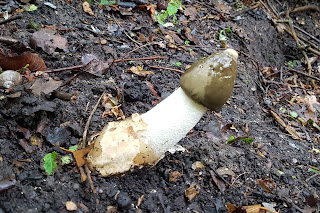As we reach the end of 2021, I'm looking over my wildlife observations and seeing what is new. I went a little further afield this year than last year. Even so, most of my sightings were within walking or running distance of my home. Numbers of new species were a little down from last year but I was busier with work and other things, so that's not surprising. At the end of the year the numbers of new species found were:
- 37 species new to my records
- of which, 23 were new to me.
 |
| Hawkweed (1 Jan 2021) |
As usual, my wildlife recording year started with the BSBI's New Year Plant Hunt. As well as the usual daisies and other opportunistic weeds I saw a Hawkweed (Hieracium), which has large, showy dandelion like flowers on tall stems.
 |
| Pyramidal Orchid, 4 July 2021 |
Another, and more exciting, botanical find was a Pyramidal Orchid (Anacamptis pyramidalis). It is supposed to prefer an alkali soil like the chalk downs but had not read the book!
 |
| Barn Owl, 2 April, 2021 |
One of my most exciting records was a Barn Owl (Tyto alba) that I disturbed while running through Buxted Park. The bird flew up from ground level and then settled on a post for a few precious seconds while I looked at it. Then it flew over my head towards the copse in the middle of the wild flower meadow. I have seen a Barn Owl before but not since I started my wildlife records.
 |
| Long-winged Conehead (14 Aug 2021) |
 |
| Opposite-Leaved Saxifrage (3 July 2021) |
In the strip of alder trees and bluebells, I found an Opposite-Leaved Saxifrage (Chrysosplenium oppositifolium). It wasn't in flower but the leaves are a pretty shape and it was a nice little find.
 |
| Hornbeam seedheads, 17 Oct 2021 |
Another plant that I found in this area was Hornbeam (Carpinus betulus). Although it is a common plant round here, I have had failed to notice and record it. Hempstead Wood is full of Hornbeams. The one photographed is in the strip of trees between the Meads and the bypass. These trees are much more tolerant of our heavy, clay soil than many other species.
 |
| Field Rose, 27 June 2021 |
On the way to Hempstead Wood, I pass some rather lovely hedgerows. Recently, I have taken the time to look at the wild roses more closely and found there are two types. As well as the usual, pink, Dog Roses (Rosa canina), there are dainty, cream-coloured Field Roses (Field Rose).
 |
| Lesser Broad-bordered Yellow Underwing, 10 Aug 2021 |
I love the subtle colours of the Lesser Broad-bordered Yellow Underwing (Noctua janthe) moth. which was hiding in our ivy. I've often found its larger, brasher cousin the Large Yellow Underwing (Noctua pronuba) everywhere from nooks and crannies in our own garden to a bar in Birmingham!
 |
| Golden Argent, 24 July 2021 |
Other garden moths included the tiny Gold Argent moth (Argyresthia brockeella) shown above and the much less welcome Box Moth.
 |
| Acorn Weevil, 5 June 2021 |
Our English Oak supports a great deal of life including the Acorn Weevil (Curculio glandium) shown.
 |
| Stinkhorn, 20 June 2021 |
As I ran down Hempstead Lane, I noticed a Stinkhorn (Phallus impudicus). They are pretty unmissable. I'm told that it really lives up to its name so I'm glad that I didn't sniff it!
 |
| Four-barred Knapweed Gall Fly, 24 July 2021 |
I saw this Four-barred Knapweed Gall Fly (Urophora quadrifasciata) in July. There are two generations, one of which overwinters in Knapweed seed heads.
 |
| Long Hoverfly, 29 Aug 2021 |
Hoverflies are useful pollinators and I was delighted to find three species that I had not noticed before including the Long Hoverfly (Sphaerophoria scripta).
So, if all goes according to plan, on New Year's day, I will start all over again. I wonder what I will find in 2022?




















